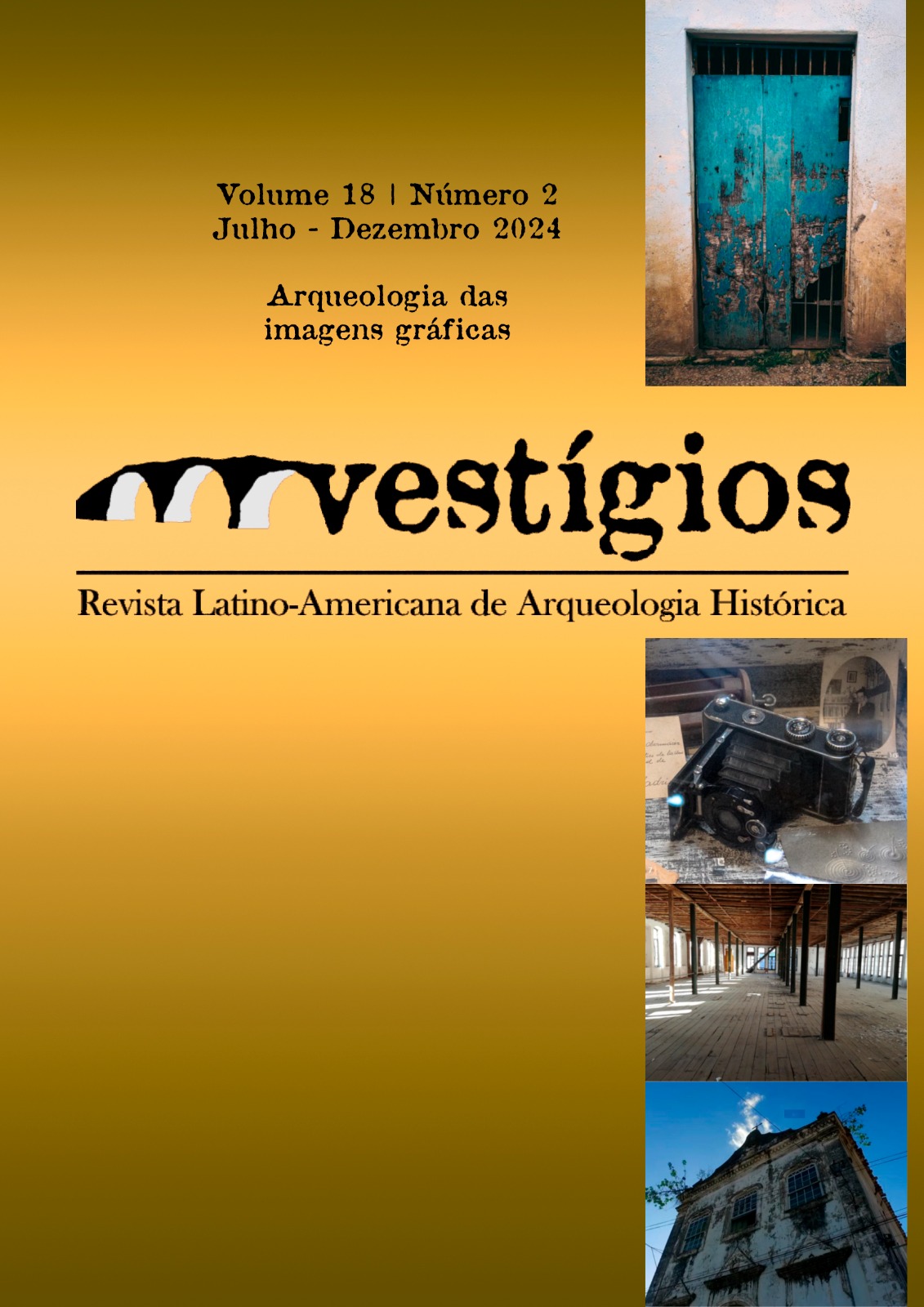Image and archaeology in the age of post-photography
reflections from a diffractive experience in Egypt
DOI:
https://doi.org/10.31239/vtg.v18i2.49580Keywords:
archaeology, documentary, theory and methodology, photographyAbstract
“No one can leave the cave”. With this phrase, Joan Fontcuberta targets the heart of the ontology of the photographic image and exposes the fictional nature of “documentary” representations of reality. The consolidation of photography as a document, a consequence of techno-scientific culture associated in the 19th century with positivism and colonial expansion, concealed its Janus Bifrons nature for nearly a century. More than “representations”, photographs are taken as substitutes for the things photographed, and this status, associated with the idea of truth, makes them the ideal visual expression medium for 20th-century science, particularly archaeology. However, the exhaustion of the guiding principles of the modern world has brought to light the dark side of the documentary moon, namely: that photographic truth, like magic, depends on a “collective agreement” that ignores its tricks and, in a “tangled web of fictions”, structures the experience of reality.
The following text investigates the origins of photographic realism and traces the paths of its overcoming, concluding with a reflection on the implications of the transcendence of documentary truth for archaeology, using as an example a “diffractive ensemble” composed of images of objects excavated from tomb TT123 in the Theban Necropolis, Luxor, Egypt, within the scope of the Brazilian Archaeological Project in Egypt (BAPE).
Downloads
References
Arago, D. F. (2013). Relatório. Em Trachtemberg, A. (org.). Ensaios sobre fotografia: de Niépce a Krauss (p. 35-44). Lisboa: Orfeu Negro.
Azoulay, A. (2019). Desaprendendo as origens da fotografia. Zum, 17. Disponível em: <https://revistazum.com.br/revista-zum-17/desaprendendo-origens-fotografia/>. [cons. 15 jan. 2024].
Barad, K. (2007). Meeting the universe halfway: quantum physics and the entanglement of matter and meaning. Durham: Duke University Press.
Barad, K. (2014). Diffracting diffraction: cutting together-apart. Parallax, 20(3), 168-187.
Barad, K. (2017). Performatividade pós-humanista: para entender como a matéria chega à matéria. Vazantes, 1(1), 7-34.
Bateson, G., & Mead, M. (1942). Balinese character: a photographic analysis. New York: New York Academy of Sciences.
Barthes, R. A câmera clara (2015). Rio de Janeiro: Nova Fronteira.
Baudelaire, C. (2013). O público moderno e a fotografia. Em Trachtemberg, A. (org.). Ensaios sobre fotografia: de Niépce a Krauss (p. 99-104). Lisboa: Orfeu Negro.
Bazin, A. (2013). A ontologia da imagem fotográfica. Em Trachtemberg, A. (org.). Ensaios sobre fotografia: de Niépce a Krauss (p. 261-266). Lisboa: Orfeu Negro.
Bonduki, I. (2015). O conceito de sequência em Nathan Lyons. Dissertação (Mestrado). Universidade de São Paulo, Escola de Comunicações e Artes, São Paulo.
Close, R. (2024). Decolonizing images: a new history of photographic cultures in Egypt. Manchester: Manchester University Press.
Didi-Huberman, G. (2013). A imagem sobrevivente: história da arte e tempo dos fantasmas segundo Aby Warburg, Rio de Janeiro: Editora Contraponto.
Didi-Huberman, G. (2019). Diante do tempo: história da arte e anacronismo das imagens. Belo Horizonte: editora UFMG.
Didi-Huberman, G. (2021). Atlas ou o gaio saber inquieto: O olho da história, III. Belo Horizonte: editora UFMG.
Dubois, P. (2004). O ato forográfico e outros ensaios. São Paulo: Papyros Editora.
Fontcuberta, J. (2016). La fúria de las imágenes: notas sobre la postfotografia. Barceloa: Galaxia Gutemberg.
Gill, S. (2005). A book of fiel studies. Londres: Chris Boot.
Haraway, D. (1997). Modest witness@Second millennium FemaleMan Meets OncoMouse™: Feminism and technoscience. New York: Routledge.
Hissa, S. (2015). Fotografia arqueológica: entre a mimese e a criação. Habitus, 13(2), 71-88.
McDonald, J. (2012). Nathan Lyons: selected essays, lectures, and interview. Austin: University of Texas Press.
Miles, M. (2010) Drive to archive: conceptual documentary photobook design. Photographies, 3(1), 49-68.
Parr, M. (2016). Real food. London: Phaidon Press.
Pellini, J. R. (2022) Encounters, affects and intra-actions: difracting the Theban Tomb 123. Archaeologies, 18, 338-369.
Pellini, J. R. (2023) The Brazilian Archaeological Program in Egypt: the first six years on TT123: assembling the puzzle.
Revista do Museu de Arqueologia e Etnologia, 40, 104-123.
Pinney, C. (1996). A história paralela da antropologia e da fotografia. Cadernos de Antropologia e Imagem, 2, 29-52.
Rouillé, A. (2009). A fotografia: entre documento e arte contemporânea. São Paulo: Editora Senac.
Ruscha, E. (1963). Twentysix gasoline stations. Los Angeles: Ed Rouscha.
Sayal-Bennett, A. (2021). Diffractive analysis: embodied encounters in contemporary artistic vídeo practice. Tate Papers, 29. Disponível em: <https://www.tate.org.uk/research/publications/tate-papers/29/diffractive-analysis>. [cons. 04 jun. 2021].
Sekula, A. (2013). Sobre a invenção do significado da fotografia. Em Trachtemberg, A. (org.). Ensaios sobre fotografia: de Niépce a Krauss (p. 387-410). Lisboa: Orfeu Negro.
Shanks, M. (1997). Photography and archaeology. Em Molineux, B. L. (ed.). The culture life of images: visual representation in archaeology (p. 73-107). London & New York: Routledge.
Smith, K. (2010). Structure of the visual book. Keith Smith Books: Rochester.
Warburg, A. (2010). Atlas Mnemosyne. Madrid: Ediciones Akal.
Van der Spek, K. (1997). Another place, a different west bank...: issues of social dislocation, heritage management, and the national interest in Upper Egypt. Bulletin of the Centre for Middle Eastern and Central Asian Studies (CMECAS), 4(1), 3-6.
Downloads
Published
How to Cite
Issue
Section
License
Copyright (c) 2024 Rogerio Pateo

This work is licensed under a Creative Commons Attribution-NonCommercial 4.0 International License.

O trabalho Vestígios - Revista Latino-Americana de Arqueologia Histórica de https://periodicos.ufmg.br/index.php/vestigios/index está licenciado com uma Licença Creative Commons - Atribuição-NãoComercial 4.0 Internacional.
Baseado no trabalho disponível em https://periodicos.ufmg.br/index.php/vestigios/index.
Podem estar disponíveis autorizações adicionais às concedidas no âmbito desta licença em https://periodicos.ufmg.br/index.php/vestigios/index.


